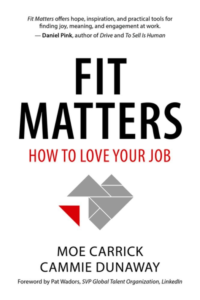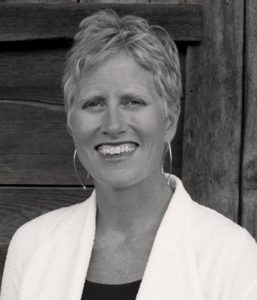Fitting in at Work is More Important to Our Careers Than We Think
Book Review — Fit Matters: How to Love Your Job
By Abigail Tetzlaff, Guest Writer
Note: I invited my work colleague, Abigail Tetzlaff, to review and write about a book that I recently received, Fit Matters: How to Love Your Job, by Moe Carrick and Cammie Dunaway. This new book about careers will help you understand if you’re a good fit for your current position — or not. In addition, it provides helpful advice to employers on how to create a culture that creates more opportunities for employees to feel like they are a good fit for what they’ve been hired to do. Enjoy. — Stephen Dupont, APR
Do you love your job? Moe Carrick and Cammie Dunaway may know why you don’t.
“A great fit at work is akin to that perfect pair of jeans that goes on easy and makes you feel good in your own skin.”
 In their book Fit Matters: How to Love your Job, Carrick and Dunaway make a formidable female duo of networkers, professionals and go-getters, discussing a holistic approach to employment. The pair astutely recognizes a trend more common than perhaps most would like.
In their book Fit Matters: How to Love your Job, Carrick and Dunaway make a formidable female duo of networkers, professionals and go-getters, discussing a holistic approach to employment. The pair astutely recognizes a trend more common than perhaps most would like.
Both authors drew from their experiences in working with large corporations as inspiration for their book. Carrick founded Momentum, Inc., a consulting firm that works with corporations such as REI, Prudential Financial, Nike and Nintendo, among others. Dunaway was U.S president and global chief marketing officer at KidZania, and formerly worked as executive vice president of sales and marketing at Nintendo, CMO at Yahoo!, and chief customer officer at Frito Lay.
Using testimonials, poll data, and other research, Carrick and Dunaway delve into the many aspects that lead to discontent in the workplace.
We’ve all had that job, whether right out of college or well into our professional careers, where we’ve used every fiber of our consciousness to make it through the day without tearing our hair out.

When an employee loses confidence and dislikes the environment in which they work, Carrick and Dunaway call this “job misfit.” In other words, there is usually nothing wrong with the employee’s capabilities or skills, nor is there usually anything wrong with the workplace’s culture or management. Rather, the employee and the workplace function too differently to be compatible, causing internal (and at times external) strife. In other words, they’re out of alignment, or possibly, were never were in alignment.
“When our job fulfills us, we thrive. But when our jobs fail us, we languish,” Carrick and Dunaway state in the early pages of their 205-page book.
With a straightforward approach, the comprehensive guide is an easy-to-digest read for individuals, recruiters, and companies seeking to understand “work misfit.” Carrick and Dunaway break down work misfit into comprehensible parts and offer practical solutions centered in mindfulness and hope.
The book can serve as an effective tool for a number of situations and audiences. In a series of detailed steps outlining the need for observation, self-actualization, and the importance of asking for help, the concepts behind “work misfit” and its cures become clear.
A vocation, like anything else in life, should be fulfilling to you. When you walk into the office, say good morning to your colleagues and boss, and grab a cup of coffee, your space and your purpose should feel right. You should want to be there, even on a Monday morning.
A job where going to work is an arduous task makes life more dreary. By being less motivated to go to work, you’re also less motivated to produce quality work throughout the day because you dread interacting with your boss, your colleagues, or constantly coming up against your workplace’s policy or culture.
Not only can a poor outlook on a place of employment cause stress to the employee while at the workplace, but also to the employee’s home life and personal relationships. This mental state, the authors suggest, is a strong symptom of “work misfit.”
The “work misfit” Carrick and Dunaway propose is not a great, insurmountable challenge, but a learning experience in a personal and professional sense. Yet, the situation should be remedied because disengaged or unhappy workers cost the company at large. It’s in the interest of health for both employee and company to find people who are compatible in a working environment.
For the employee, they suggest that instead of wallowing in a work misfit situation it’s important to use the experience to learn about yourself, practice more effective communication, and embrace the lessons learned from a work misfit experience to help you avoid similar situations in the future.

“In this book, we offer what we believe is a key ingredient for work that’s essential for you today and tomorrow: hope,” Carrick and Dunaway say. “The hope that, for most of the days you spend working, you’ll feel good. The hope that meaning and value and contribution will be yours more often than not, resulting in greater alignment, satisfaction and joy.”
Identifying a Good Fit
Outlined in their philosophy, the elements of job “fit” are more combinatorial than simply fair wages. Carrick and Dunaway give readers a bisected view of incompatible work environments and people just as a professor of medicine shows her students how the body works beneath the skin.
They highlight six elements that define good fit. These elements can then be used to assess where an employee feels most mismatched with their jobs. The primary elements are:
Meaning Fit: where your work matters to you, and the broader company does work that is compatible with your values;
Job Fit: where your responsibilities incorporate your unique talents and provide opportunities to grow professionally;
Culture Fit: where your values and beliefs are compatible with your employer;
Relationship Fit: where the people you work with support each other and allow trust bonds to form;
Lifestyle Fit: where your life outside work is complemented by the policies and practices of your company; and
Financial Fit: where you feel you’re being paid fairly, and that pay meets your needs.
Their logic echoes that of Dr. Mihaly Csikszentmihalyi, distinguished psychologist and author of Flow: The Psychology of Optimal Experience, who also determined points that lead a person’s fulfillment in their work environment. A mixture of challenge, control, and drive propels employees to succeed over anxiety, worry and apathy.
Carrick and Dunaway’ six elements for “good fit,” also provides a structure for employers in developing a healthy, productive workplace.
Workers who do not feel comfortable or confident in their workplaces, due to any number of stressors, are at the risk of developing or worsening mental and physical ailments due to their distress – and possibly affecting those around them. It’s the responsibility of organizations to wisely seek and hire team members who are the best fit for a company’s mission and culture based on interviews and, more importantly, honest communication.
“Employees want to be in an environment where their values and beliefs are aligned with the organization and where they feel support to do their best work,” note Carrick and Dunaway.
In other words, without proper support, an employee cannot produce to their highest level, nor give an organization at large the most valuable product the employee can yield.
Combating the idea that work misfit just exists without any solution, the authors’ voices act as an assuring counselor who speaks directly to experience, constantly validating and informing the reader. Continually, Carrick and Dunaway express that while “misfit” in a workplace can be critical to a person or a company’s well being, such feelings are altogether preventable through a proactive focus on good fit.
 Abigail Tetzlaff is a senior at Augsburg College in Minneapolis, Minn. She studies English Literature, German Language, and Sociology. She is managing editor of The Echo, the student-run newspaper of Augsburg College, and editor-in-charge of Murphy Square literary magazine, and the journal, Honors Review.
Abigail Tetzlaff is a senior at Augsburg College in Minneapolis, Minn. She studies English Literature, German Language, and Sociology. She is managing editor of The Echo, the student-run newspaper of Augsburg College, and editor-in-charge of Murphy Square literary magazine, and the journal, Honors Review.